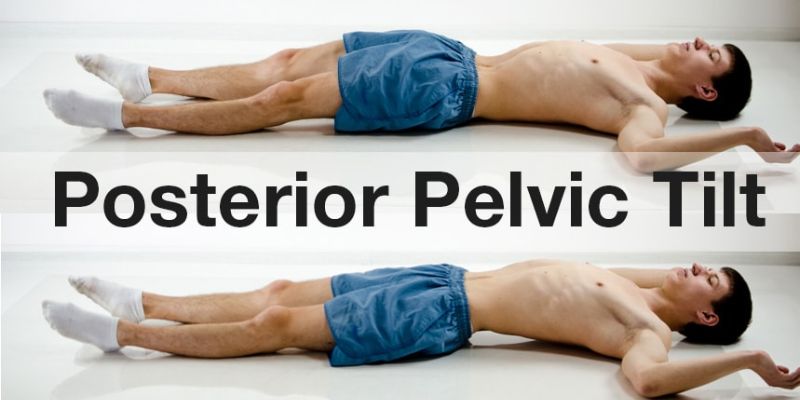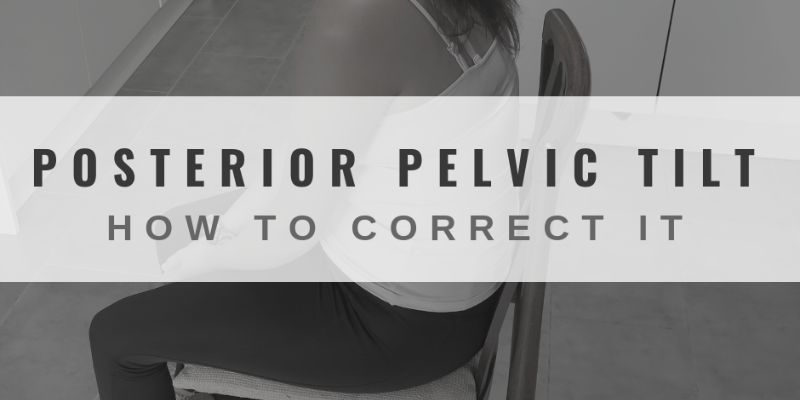Are you new to the world of fitness and exercise? If so, you may have heard of a concept called "posterior pelvic tilt" but aren't sure what it means. Don't worry – you are not alone!
In this blog post, we will break down everything there is to know about posterior pelvic tilts: from the basics of how muscles interact with our bodies on an anatomical level to exercises designed specifically for posterior pelvic tilting.
We will also explore some benefits of proper posture and provide tips for mastering posterior pelvic tilting safely and effectively. So read on if you want to learn more about this important concept!
What is a Posterior Pelvic Tilt

The posterior pelvic tilt is a postural misalignment in which the pelvis is rotated backward. This causes the lower back to arch, leading to low back pain, poor posture, and a lack of core strength and stability.
The main muscles involved in this condition are the gluteal (buttock) muscles, hip flexors, and abdominal muscles. When these muscles become weak or tight, they can cause the pelvis to tilt backward, creating a "shearing" effect on the spine.
The posterior pelvic tilt is not an uncommon problem – in fact, many people develop this condition from sitting for long periods or due to poor posture habits. Fortunately, there are several exercises you can do to help correct the alignment of your pelvis and improve your posture.
Posterior Pelvic Tilt Causes
The posterior pelvic tilt is an imbalance in the positioning of the pelvis that leads to excessive arching in the lower back and can cause pain, poor posture, and reduced core strength. There are several causes for posterior pelvic tilt, which include:
- Weakness or tightness in the gluteal (buttock) muscles, hip flexors, and abdominal muscles.
- Habits include sitting for long periods, slouching while standing or sitting, or sleeping on your stomach.
- Imbalances between the leg muscles and the core muscles.
- Long-term tightness in the hamstrings can contribute to posterior pelvic tilt.
- Anatomical factors such as differences in hip joint flexibility.
- Poor posture and lack of movement over time.
- Low back injuries or trauma can disrupt the body's alignment.
Maintaining good posture and proper alignment is essential for avoiding posterior pelvic tilt and optimizing performance during physical activity. Knowing your posture throughout the day is important to quickly adjust if needed.
How Do I Know If I Have Posterior Pelvic Tilt
Awareness of the signs and symptoms associated with posterior pelvic tilt is important. Thus, you can address it as soon as possible before it becomes a more serious issue. Common signs of posterior pelvic tilt include:
- Slouched Posture: A noticeable change in posture, such as slouching or arching of the lower back, indicates posterior pelvic tilt.
- Tightness in Your Abdominals and Hamstrings: Tight abdominal muscles can pull on the lower spine, creating an excessive backward tilt of the pelvis. Similarly, tight hamstring muscles can also lead to a posterior pelvic tilt.
- Low Back Pain: An excessive backward pelvis tilt can reduce the natural curve in your lower spine, leading to low back pain or tension.
- Knee and Hip Pain: When the pelvis is tilted backward, it can create an imbalanced alignment of the hip joints resulting in knee or hip pain.
- The appearance of a Flat Back and Tucked Glutes: When the pelvis is tilted too far back, your glutes will appear as if they're tucked in. This can be a sign of posterior pelvic tilt.
How to Fix a Posterior Pelvic Tilt

Sleeping Adjustments
Good sleeping posture is essential for avoiding and reducing the effects of a posterior pelvic tilt. Poorly aligned posture while sleeping can cause strain and pain in the lower back, especially if you are already dealing with a posterior pelvic tilt.
To improve your posture during sleep, finding an appropriate pillow that supports your neck and spine's natural curve is important. A mattress that is too hard or soft can also disrupt your posture and cause further complications. The best mattress for your needs is comfortable but provides adequate support to the lower back, hips, and spine.
In addition to finding a comfortable sleeping position, there are other adjustments you can make to help improve your posture. For instance, if you are a side sleeper, try placing a pillow between your knees to keep the hips in alignment.
If you sleep on your back, putting a small pillow between your knees can assist your spine's natural curve. Another helpful suggestion is to place a small pillow or cloth behind the arch of your back when on your back.
Treating Posterior the Pelvic Tilt While Sitting
Treating posterior the pelvic tilt while sitting involves adjusting the chair and body posture. The goal is to find a comfortable position that allows proper spinal alignment.
First, it's important to use a chair with good lumbar support or consider using a pillow at your lower back for additional support. Additionally, adjust the chair height so that your feet are flat on the floor and your hips are slightly higher than your knees. This helps keep your spine in a neutral position.
Keeping your head up with your ears aligned over your shoulders is also essential. Try not to crane or slouch while sitting, which can cause additional strain on the lower back and disrupt proper spinal alignment.
If possible, avoid sitting for long periods. Take breaks throughout the day to move around and stretch your muscles. For example, practice exercises such as hip flexor or quadriceps stretching every 30 minutes while seated.
Corrective Exercises
Corrective exercises are a great way to help alleviate the symptoms associated with posterior pelvic tilt. These exercises can strengthen weak muscles, improve flexibility, and create better alignment for optimal posture.
One of the most beneficial corrective exercises for posterior pelvic tilt is strengthening the gluteal (buttock) muscles. Weak glutes can lead to an excessive arching of the lower back, which can cause pain and tightness in the hips and knees. Exercises such as squats, lunges, hip bridges, clamshells, and mini-band exercises are all great options for strengthening the glutes and improving posture.
Another important corrective exercise is stretching the hamstrings. The hamstrings are located on the back of the thighs and can become tight and overworked with poor posture. Regular stretching of the hamstrings helps to reduce tension in the lower back and improve hip mobility. Examples of hamstring stretches include standing toe touches, seated forward bends, straight leg raises, and lying hamstring stretches.
Core strengthening exercises are also key for improving posterior pelvic tilt. Strengthening your core helps keep your spine aligned, reduces back pain, and promotes a more upright posture. Planks, bridges, mountain climbers, side planks, and reverse crunches are all excellent exercises for strengthening the core muscles.
Lastly, dynamic stretching can help improve the range of motion and flexibility throughout the body. Dynamic stretches involve gradual movement through a range of motion, such as walking lunges, leg swings, or arm circles. Incorporating dynamic stretches into your routine can help improve posture and reduce the risk of pain and injury due to posterior pelvic tilt.
FAQs
Can you correct the posterior pelvic tilt?
Yes, there are many things you can do to correct posterior pelvic tilt. This includes adjusting your sleeping posture, taking breaks from sitting in the same position for long periods, and performing exercises that strengthen and stretch the relevant muscles.
What are examples of posterior pelvic tilt?
Examples of posterior pelvic tilt include tight abdominal muscles, tight hamstrings, low back pain or tension, knee or hip pain, and the appearance of a flat back and tucked glutes.
Are there any benefits to mastering posterior pelvic tilting?
Yes! Mastering posterior pelvic tilting can help reduce lower back pain and improve your posture overall. It can also help prevent tightness in the hips, knees, and hamstrings and reduce strain on the lower back muscles.
Conclusion
Posterior pelvic tilt is a common problem that can cause pain and discomfort in the lower back, hips, and knees. Some factors, including weak glutes or tight abdominal and hamstring muscles, can cause it. But with the right adjustments to your sleeping posture, breaks from sitting for long periods, and corrective exercises designed specifically to target the relevant muscles involved in this condition, you can reduce or even eliminate the effects of posterior pelvic tilt.

Discover the Top 12 Health Benefits of Incorporating Corn into Your Diet
Nov 08, 2023

Exercising with a Cold: Yay or Nay?
Nov 04, 2023

Demystifying the Wonders of Lactic Acid in Skincare
Nov 03, 2023

Knee Brace May Help Torn Anterior Cruciate Ligaments Heal Themselves: An Overview
Oct 18, 2023

Optimal Leg Workout Routines for Strength and Muscle Tone
Nov 09, 2023

Dialectical Behavior Therapy (DBT): A Beacon for Emotional Regulation
Oct 04, 2023

Health benefits of walnuts
Nov 06, 2023

Exploring the Origins of Eczema
Nov 01, 2023



